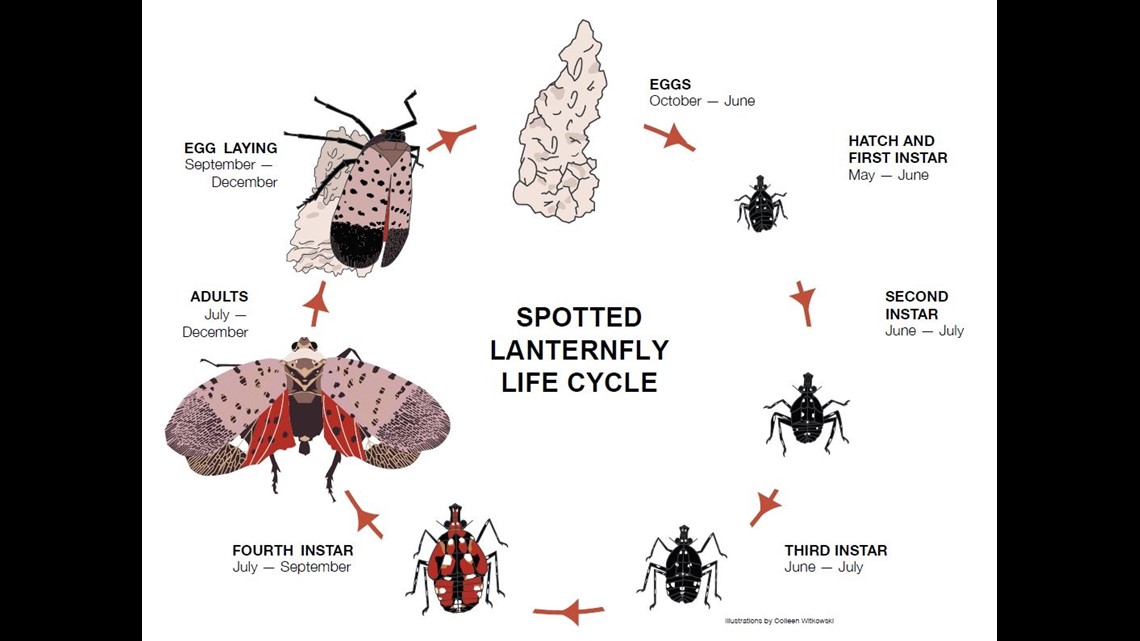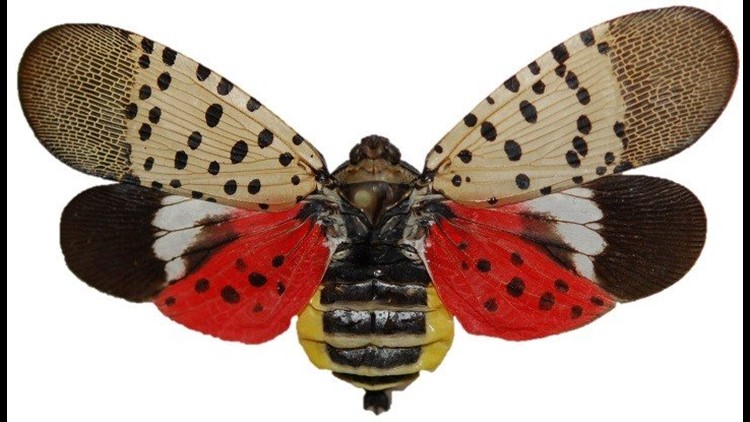STATE COLLEGE — State officials are attempting to curtail the spread of the spotted lanternfly across Pennsylvania.
After first being found in Berks County in 2014, 13 counties in Pennsylvania, including Lebanon and Lancaster counties, are now under quarantine because of activity by the invasive insect.
Here’s everything you need to know about the bug. Information is provided by the Penn State Extension:
What is the spotted lanternfly?
The spotted lanternfly is an invasive planthopper (a type of insect) in the U.S. It is native to certain parts of Southeast Asia.
Are they a threat here?
Spotted lanternflies feed on the sap of a plant, and when there are high populations of them, they can cause significant damage. They feed on over 70+ plants, including important forestry and agricultural crops. Spotted lanternfly was first discovered in the United States in Berks County in 2014. It has since spread throughout 13 counties in southeastern Pennsylvania, which the Pennsylvania Department of Agriculture has designated as a spotted lanternfly quarantine zone.
In 2017, spotted lanternfly was also found in Frederick County in Virginia. In 2018, three New Jersey counties (Mercer, Warren, and Hunterdon) were quarantined for spotted lanternfly.
How do you identify a spotted lanternfly? What do you look for?
Spotted lanternflies go through five stages of growth after hatching from eggs. The first four stages are called nymphs, which are incapable of flight. The young nymphs are black with bright white spots and are roughly the size of a pencil eraser. The next stages of growth are similar, but the nymphs become larger.
The fourth stage of spotted lanternflies, prior to adulthood, is vibrantly red with distinct patches of black and equally distinct bright white spots. The adult spotted lanternfly is a leafhopper with wings about 1” long. Adults have grey wings with black spots. When the spotted lanternfly opens its wings, it reveals a bright red underwing. Spotted lanternflies live through the winter only as eggs. Adults lay eggs in masses in the late fall on trees, under bark, posts, lawn furniture, cars, trailers, outdoor grills, and on many other surfaces.
I think I caught or killed a spotted lanternfly. What do I do with it now?
If you find a spotted lanternfly or a suspicious looking egg mass in a municipality where it is not known to exist, you should try to collect it and put it into a container filled with alcohol (rubbing alcohol, hand sanitizer, etc.) to kill and preserve it, or at least take a good picture of it.
Report your sighting online to the Pennsylvania Department ofl Agriculture, or call Penn State Extension at 1-888-4BADFLY (1-888-422-3359). Your discovery could add additional municipalities to the quarantined area.If you find any life stage of spotted lanternfly in a municipality where it is already known to exist, you should try to destroy it.
Do spotted lanternflies kill trees or plants?
In Korea, spotted lanternflies have had a major destructive impact on grapes, and grape-products such as wine. Spotted lanternflies have also reduced yields on important fruit-bearing trees and other plants. The spotted lanternfly feeds on more than 70 types of plants, including crops such as grapes, apples, hops, walnuts and other hardwood trees.
Are spotted lanternflies dangerous to children or pets?
Spotted lanternflies are not known to bite or sting or attack people, pets or livestock. And it is not known if spotted lanternflies are poisonous when ingested by humans or animals.
But because of the damage spotted lanternflies do to agriculture and forestry products, they are a threat to the economic well-being of our state and its citizens.
Can I prevent spotted lanternflies from getting on my property?
The best thing any property owner can do is become informed about spotted lanternflies. By becoming informed, property owners can choose to remove and/or treat the Ailanthus (tree-of-heaven) trees on their properties, which attract the insects.
In addition, property owners can reference the Spotted Lanternfly Management for Homeowners guide for using contact pesticides and treatments on a variety of trees and plants.
What happens if my borough/township/county gets quarantined for spotted lanternflies?
The quarantine for spotted lanternflies is an important legal designation. The citizens of municipalities under a quarantine order can follow simple directions to ensure that each citizen complies with the law.
The Pennsylvania Department of Agriculture quarantine order directs citizens and municipal authorities to follow guidelines to prevent the movement of spotted lanternflies at any stage of development. These guidelines direct citizens to inspect all wood and vegetation that might leave the quarantined municipality.
In addition, these guidelines direct citizens to inspect vehicles, trailers, and other mobile equipment prior to moving such equipment out of the quarantine.
Why are there quarantines in some areas but not others?
The Pennsylvania Department of Agriculture conducts ongoing and careful surveys of all of Pennsylvania. Department crews survey for evidence of spotted lanternflies using detailed visual and trapping methods. Once the department’s survey crews find evidence of spotted lanternflies in an area, the evidence is scientifically analyzed by both Pennsylvania Department of Agriculture entomologists and by scientists from the United States Department of Agriculture. After this process, a township, borough, or city can be quarantined by the state department of agriculture.
What’s at stake?
From what we know, the spotted lanternfly is a significant threat to Pennsylvania agriculture, landscapes and natural ecosystems, including grape (where heavy damage has already been recorded), tree-fruit, hardwood, and nursery industries, which collectively are worth nearly $18 billion to the state’s economy, as well as for outdoor recreation, backyard enjoyment, and biodiversity. The insect can also result in significant economic impacts from restrictions on commerce within quarantine zones.
How does the spotted lanternfly feed? What is honeydew?
The spotted lanternfly feeds through the bark using a piercing-sucking mouthpart tapped into the plant like a straw. When it feeds, it excretes honeydew, or sugary water on and around it’s feeding site. This encourages the growth of black sooty mold, which is not harmful to humans, but can damage plants and make outside recreation areas unusable.
Does the spotted lanternfly bite or sting?
No, it does not bite or sting.
Is fruit, etc., safe to eat in quarantine zones?
Yes, fruit from the quarantine area is safe to eat. The spotted lanternfly feeds on the plant, not the fruit.
Does the spotted lanternfly have any natural enemies?
Some common insect predators such as spiders and praying mantises have been found to attack spotted lanternfly. However, this is not enough to reduce their population, and there are no other known natural enemies for this pest in the U.S.
What is being done to control the spotted lanternfly?
Both the U.S. and Pennsylvania Departments of Agriculture are working on control and eradication measures in the quarantine zone. Primarily, this involves removing their preferred host (an invasive plant called tree-of-heaven), and leaving “trap trees”, which are trees baited with insecticides to kill the spotted lanternflies.
What can homeowners do to help control the spotted lanternfly?
There are few control options for homeowners. In the fall and winter, we recommend scraping egg masses. In the spring, we recommend banding highly infested trees with sticky tape, to trap the nymphs crawling up the trees to feed. For both nymphs and adults, insecticides can be used. Find out more information by downloading our Homeowner’s management guide.
Why are spotted lanternflies spreading so fast?
Because spotted lanternflies lays eggs on almost any surface, including vehicles like rail cars and trailers, as well as outdoor equipment and patio furniture, the pest is easily spread by people. Before you travel within or out of the quarantine zone, check your belongings, yourself, and your vehicle for spotted lanternfly.
How can I help?
Report your sightings of spotted lanternfly using our online reporting tool, or by calling 1-888-4BAD-FLY. Make sure you are not moving any life stage of spotted lanternfly when traveling within or out of the quarantine zone. And finally, tell your friends, family, and neighbors! The more you can spread awareness about the insect, the better chance we have against fighting it!
SOURCE: Penn State Extension





